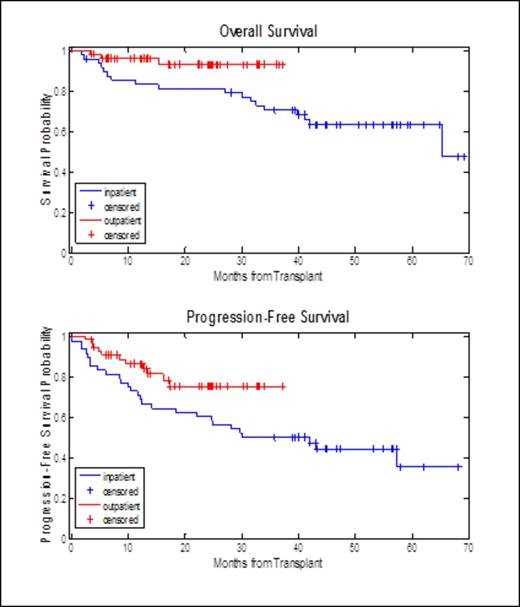Abstract
High dose chemotherapy followed by autologous hematopoietic stem cell transplantation (AHSCT) is standard consolidative treatment for patients with Hodgkin’s or non-Hodgkin’s lymphoma that persists or recurs following standard chemotherapy and/or radiation (Philip, T et al, 1995; Linch, D.C et al, 1993). The BEAM regimen (Carmustine (BCNU), Etoposide (ETP), Cytarabine (Ara-C), and Melphalan (Mel)) is often utilized as the conditioning regimen for AHSCT (Mills, W et al, 1995). Traditionally, patients are admitted for conditioning and remain hospitalized until hematologic recovery. We implemented a protocol for outpatient administration of BEAM followed by admission for stem cell infusion and post-transplant supportive care. To evaluate safety and consequences of outpatient conditioning, we compared outcomes of lymphoma patients receiving outpatient BEAM (OP BEAM) to a previous cohort receiving inpatient BEAM (IP BEAM) chemotherapy prior to AHSCT.
Methods: We reviewed charts of all 58 lymphoma patients who received OP BEAM for AHSCT from Feb 2011 to Mar 2014. Patients were required to stay within 30 minutes of the hospital and have a full-time caregiver. There were no other exclusion criteria. The OP BEAM regimen was BCNU 300 mg/m2 IV day -6; ETP and Ara-C 200 mg/m2 IV each, daily days -5 to -2; Mel 140 mg/m2 IV day -1; admission and stem cell infusion day 0. For comparison, we reviewed charts of 49 consecutive patients who received IP BEAM conditioning from July 2008 to Jan 2011. The IP regimen was BCNU 300 mg/m2 IV day -7; ETP and Ara-C 100 mg/m2 IV each, every 12 hours days -6 to -3; Mel 140 mg/m2 IV day -2; rest day -1; stem cell infusion day 0. Toxicities were graded according to NCI criteria. Infection required antimicrobial treatment for clinical symptoms plus radiographic or microbial confirmation. Continuous variables were compared using the nonparametric Wilcoxon Test. Categorical variables were compared using Fisher’s exact test. Kaplan-Meier curves were compared using the log-rank test.
Results: Patient and disease characteristics were comparable between the IP and OP BEAM cohorts: median age (58.5, 57.5 yr, p=0.83); male (61.2%, 65.5%, p=0.69); diagnosis (follicular, DLBC, transformed, mantle cell, marginal zone, Hodgkin’s, other, p=0.92); disease status (CR1, CR>1, VGPR, PR, RD, p=0.50); lines of prior therapy (range 1-6, p=0.23); HCT comorbidity index (range 0-8, p=0.85). Median CD34 doses were also similar: 4.18 vs 4.48 x106/kg (p=0.72). Due to the different time periods for IP BEAM and OP BEAM, length of follow-up was significantly different, with medians 42.1 (range 1.8-69.4) and 17.3 (3.2-37.3) months respectively (p<0.0001).
Median LOS was 6 days less for OP BEAM, 18 vs 12 days (p <0.0001). No OP BEAM patient required early admission due to toxicity. Neutrophil engraftment occurred at a median of 10 days for both cohorts. Median platelet engraftment was 10 days for IP BEAM and 11 days for OP BEAM (p= 0.17). Incidence and severity of nausea/vomiting, oral mucositis, and neutropenic fever were similar but significantly fewer patients developed infections, severe enteritis, or grade 2-4 organ toxicity in the OP BEAM cohort (Table 1). Overall and progression-free survival were also significantly different between the IP and OP BEAM cohorts (p=0.03 for both, Fig 1).
| . | IP BEAM #Pt (%) . | OP BEAM #Pt (%) . | P . |
|---|---|---|---|
| Nausea/Vomiting | |||
| Grade 2-3 | 17 (34.7) | 14 (24) | 0.29 |
| Oral Mucositis | |||
| Grade 2-3 | 11 (22.4) | 9 (16) | 0.46 |
| Enteritis | |||
| Overall | 0.004 | ||
| Grade 0-1 | 25 (51.0) | 43 (74.1) | 0.02 |
| Grade 2-3 | 18 (36.7) | 15 (25.9) | 0.29 |
| Grade 4 | 6 (12.2) | 0 | 0.01 |
| Organ toxicity | |||
| Grade 2-4 | 14 (28.6) | 5 (8.6) | 0.01 |
| Neutropenic fever | 33 (67.4) | 30 (51.7) | 0.12 |
| Infection | 22 (44.9) | 15 (25.9) | 0.04 |
| . | IP BEAM #Pt (%) . | OP BEAM #Pt (%) . | P . |
|---|---|---|---|
| Nausea/Vomiting | |||
| Grade 2-3 | 17 (34.7) | 14 (24) | 0.29 |
| Oral Mucositis | |||
| Grade 2-3 | 11 (22.4) | 9 (16) | 0.46 |
| Enteritis | |||
| Overall | 0.004 | ||
| Grade 0-1 | 25 (51.0) | 43 (74.1) | 0.02 |
| Grade 2-3 | 18 (36.7) | 15 (25.9) | 0.29 |
| Grade 4 | 6 (12.2) | 0 | 0.01 |
| Organ toxicity | |||
| Grade 2-4 | 14 (28.6) | 5 (8.6) | 0.01 |
| Neutropenic fever | 33 (67.4) | 30 (51.7) | 0.12 |
| Infection | 22 (44.9) | 15 (25.9) | 0.04 |
Conclusions: Outpatient administration of BEAM conditioning prior to AHSCT for patients with lymphoma decreases hospital stay and is not only safe, but may result in improved short and long term outcomes. This study is limited by sequential treatment dates and minor differences in the regimens for IP and OP BEAM. However, the cohorts were comparable with regard to patient and disease characteristics. A decrease in LOS by 6 days with OP BEAM is expected to translate to substantial health care savings, more efficient hospital bed utilization and increased patient satisfaction. Outpatient BEAM conditioning is now our standard approach for AHSCT for lymphoma and may be more broadly applicable to other settings.
No relevant conflicts of interest to declare.
Author notes
Asterisk with author names denotes non-ASH members.


This feature is available to Subscribers Only
Sign In or Create an Account Close Modal